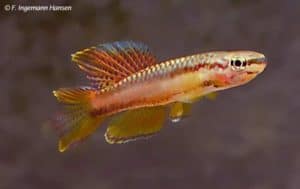Lucania goodei – Bluefin Killifish
Lucania goodei was described by Jordan in 1880. Their common name is Bluefin Killifish. This species belongs to the Order Cyprinodontiformes or tooth carps, family Fundulidae a family of killi fish.
The name Lucania is derived from the Italian province of Lucania, near Tarento. The genus name goodei is named after Dr. G.B. Goode, an American ichthyologist, who was the first to collect this fish.
Previous names: Lucania goodei (JORDAN 1879); Funclulus goodei (WOOLMAN 1892); Fundulus (Chriopeops) goodei (Fowler 1916); Chriopeops goodei MYERS, 1924
Description
Lately I don’t see this killifish anywhere anymore, while it is still a very nice fish. At the end of the fifties and early sixties of the 20th century, I enjoyed a school (from that time called Chriopeop’s goodei fish) in my community aquarium for many years. I also bred with them.
It is a typical Fundulus-like but with a more spindle-shaped body. Maximum length 6 centimeters, in aquariums in most cases rarely more than 5 centimeters. Their body is oval shaped. It is a streamlined elongated fish, the height is around a quarter of the length from nose to caudal peduncle.
The dorsal fin starts halfway along the body length, while the anal fin begins slightly further back. The snout is rounded, and the mouth is terminal with an upward-facing opening. Lucania differs from other Fundulus-like species in that it has two rows of teeth in its jaws.
As far as can be ascertained, their lifespan is around 2 years.
Biotope
Subtropical freshwater that has pH values between 6.5 and 6.8 due to humic acids and temperatures ranging from 12 ° to 22 ° C.
They live in slow-flowing and stagnant waters, lakes and swamps, in pools, ponds, and streams, which are generally densely overgrown with plants. Often seen in the vicinity of natural wells.
Swim in schools, usually quite far below the surface of the water. Although belonging to the killis, it is not a real seasonal fish. It is fairly easy to keep in an aquarium.
Distribution/origin
North America, in Florida, except to the west of the delta of the Choctawhatchee River; very rarely also along the Atlantic coast to central South Carolina, in southeastern Alabama in the delta of the Chipola river.
Has also been released into the wild in California, Texas and North Carolina.
Care
The natural habitat of this species is primarily the stagnant marshy waters of Florida. Lucania goodei does not inhabit the more brackish coastal waters, which are also marshy.
An important aspect to note is the temperature range in this area. While summer temperatures are almost tropical, winters can become quite cold. As a result, this species can tolerate temperatures as low as 5° Celsius and as high as 25° Celsius.
According to some descriptions, it is best to keep this tooth carp, together with species that occur in the same habitat, such as Fundulus chrysotus, Elassoma evergladei, Jordanella floridae et al: at room temperature in an unheated aquarium. My own experience was that the fish did well in the tropical community aquarium at the time, although it is not excluded that keeping it permanently at higher temperatures can lead to a shorter lifespan.
The bottom is preferably covered with a substantial layer of humus (for example peat) and the aquarium is heavily planted with, for example, Myriophyllum, Najas, Bacopa, Heteranthera, and the like. As food, they prefer small insects and insect larvae, but also small invertebrates (daphnia or cyclops) and dry food are eaten without problems.
Like many Fundulus-like species, they are quite sensitive to changes in the composition of water, so never transfer directly from one aquarium to another. They are less tolerant of fresh tap water than supplementing with rainwater.
Breeding Lucania goodei – Bluefin Killifish
At breeding temperatures above 23-24 ° C, most eggs remain unfertilized, practice shows that the optimum temperature for the sperm to achieve successful fertilization is 18 to 19 ° Celsius.
Mating can, just as with related species, sometimes get quite intense. The eggs are deposited in the upper water layers, on and between the fine-leafed leaves of plants. Two to five eggs per spawn, but they spawn daily for several consecutive weeks. In total, up to 200 eggs are produced in this way.
The yellowish-brown eggs are quite large (about 2 mm in diameter) and stick to the plants with short, slimy threads. The eggs hatch after one week or ten days depending on the temperature.
The young grow up quite quickly and after about 5-6 weeks we see the red tail developing in the males.
Video
Author
Menno van Veen
Copyright images
Rudolf Pohlmann – Killifishe.info – Facebook
Resources












